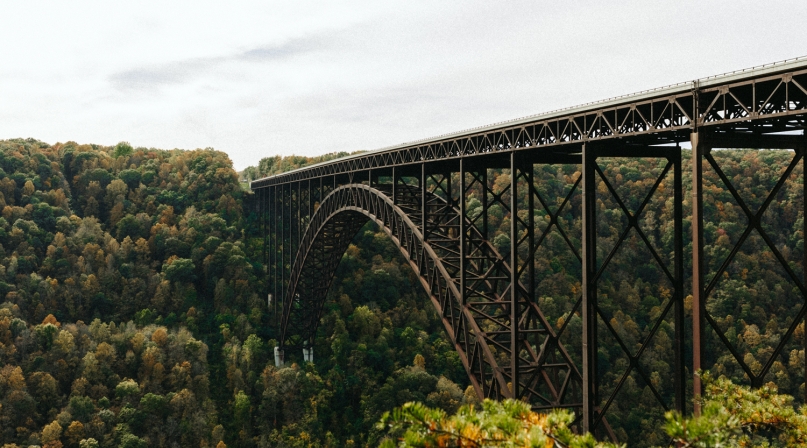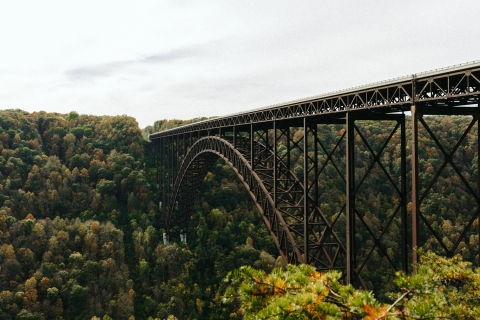Outdoor tourism offers covid-safe opportunities

Key Takeaways
Its birth announcement may have been buried deep in December’s omnibus spending bill, but a quartet of West Virginia counties are welcoming New River Gorge National Park and preparing for visitors.
Though the timing of the designation was a surprise, it was not unexpected, because the four counties involved in planning — Fayette, Raleigh, Summers and Nicholas — have been working toward this goal for more than 30 years. And it’s happening when outdoor recreation is seen as one of the safest options during the COVID-19 pandemic, making the glittering lure of a new national park, and its wide-open spaces, even brighter.
“The counties realize they could be inundated very soon,” said Jina Belcher, executive director of the New River Gorge Regional Development Commission, which coordinates business development in the four counties. “Over the last three or four years, we have been trying to figure out how we capitalize on what that outdoor industry really looks like. Is it recruiting outdoor manufacturers? Is it focusing on the existing outdoor assets and infrastructure that we have? Is it positioning ourselves to be able to support the development of new and growing outdoor infrastructure such as our trails? Is it just business recruitment and site development? We found it’s all of that. It takes all of that to cultivate a growing outdoors industry.”
Though West Virginia, “Wild and Wonderful,” has pivoted toward outdoor recreation for years to transition from coal mining, having the 70,000-acre park and preserve, complete with the grand bridge spanning the gorge — which appears on the state’s quarter — puts it on a whole different map.
Learn More
Best practices for building outdoor recreation economies
The Outdoor Recreation Roundtable identifies the following principles for enabling community-centric, place-based sustainable economic development around outdoor recreation assets. Learn more from the Outdoor Recreation Roundtable Rural Economic Development Toolkit.
- Identify and empower local champions
- Unify behind consistent messaging
- Make outdoor recreation a “must have”
- Build collaboratives
- Guarantee buy-in and dependability
- Identify one point of contact
- Generate public support
- Provide professional development
- Create a brand
- Identify funding partners
- Achieve buy-in from the state
- Plan for destination management
- Ensure value capture
- Take on basic infrastructure needs
- Attract and support outdoor business
“I feel like it’s going to get attention and eyeballs that it wasn’t before,” said Greg Duckworth, a Raleigh County commissioner. “Why pass West Virginia to go see the Great Smoky Mountains? We have plenty of mountains here.”
His poke at the Smokies was purely in jest; Duckworth hopes that his county and the others in the region can capitalize on what other “gateway” counties have learned as he sees the two parts as complementary, rather than competitive.
“We’d like to make it easy for visitors to embrace the local flavor while they’re here,” he said. “Eat at our local restaurants, stay in our hotels and we’ll try to keep them around and into other parts of the county to see what else we have.”
The Bureau of Economic Analysis estimates that outdoor recreation in 2019 accounted for $459.8 billion, or 2.1 percent of current-dollar gross domestic product. More than a quarter came from accommodations, food services and more, with another one-fifth coming from retail trade.
Michelle Rotellini, president and CEO of the Beckley-Raleigh County Chamber of Commerce, eyes the region’s growing outdoor recreation profile as the kind of setting that could attract new residents, now that a year’s worth of remote work is proving to be more feasible for some sectors of the economy.
“Why live in Silicon Valley and deal with that cost of living and traffic when you can live and do your job and have all of these outdoor recreation opportunities right out of your back door?” she said. “The changes the pandemic has made in our lifestyles has opened up opportunities for West Virginia.”
Over the next few months, Belcher’s organization will identify local needs and develop a short-term strategy to handle the influx of visitors. That includes analyzing the region’s stock of short-term housing rentals and infrastructure related to outdoor recreation and planning what the counties need to maximize the benefits of the visitors. She’ll consult with the Appalachian Regional Commission and the state for funding opportunities.
“It was very important that all four counties were really bought into this — it’s really caused them to rethink their community strategies and their county strategies individually to figure out how they best complement this particular industry,” Belcher said. “They recognize that a regional approach for economic development is what is going to move these counties forward. They’re very different but they’re all tied together with this component of the New River Gorge.”
San Benito County, Calif. went through similar experiences in 2013, when Pinnacles National Monument became Pinnacles National Park. The park straddles the line with Monterey County to the west, the eastern gateway in San Benito leads to campsites and the visitor’s center and draws the lion’s share of visitors.
“We saw a major boost in visitors when the Pinnacles became a national park,” said Jennifer Rodriguez, director of tourism and hospitality for the San Benito County Chamber of Commerce. “That alone helped us promote tourism and outdoor recreation, which we are relying on heavily right now. It’s a blessing to have a national park in our backyard.”
After the designation, the county’s chamber of commerce shifted gears to cater specifically to visitors.
“We started having conversations with the city and the county, having them provide funding toward tourism efforts,” said Michelle Leonard, the chamber’s president and CEO. “We really wanted to market the entire community to everyone who came to the park and that meant getting everyone on board.” She hired Rodriguez to coordinate the county, city, park superintendent and businesses.
The businesses themselves changed.
“We noticed an increase in the type of business that would appeal to outdoor-daytrip enthusiasts — taprooms, breweries, wineries, adventure-based businesses,” Leonard said. “Businesses are approaching their branding and offerings with more intentionality and cohesiveness, whether it’s something on their menu or their décor that really pays homage to Pinnacles National Park. It’s a deliberate effort to tie into what we have here.”
While the “honeymoon phase” has ended and the initial rush of visitors abated, Rodriguez noted an increase in visitors in 2020, which she attributed to the pandemic.
“We’ve generally hit a new mindset where people want to get back to camping, hiking, being outside,” she said. “There’s a really big opportunity if you’re a county with outdoor recreation opportunities, or a national park.”
That said, not every county has a national park. Harlan County, Ky. doesn’t, but nearly 20 years ago, a group of off-road driving enthusiasts started building their own attraction.
“We were looking for a place to ride where we wouldn’t be trespassing on people’s property,” said Ken Crider, treasurer of the Harlan County Outdoor Recreation Board Authority, which the county’s Fiscal Court formed in 2005.
“We took the judge/executive to some off-roading events and he saw how many people came to those and he was interested in making sure we could make that happen in Harlan County.” With a 25-year lease on 7,000 acres, the authority developed 150 miles of trails using a network of former mining and logging roads on what became Black Mountain Off-Road Adventure Area. Crider manages the park’s operations, which include a zipline network.
“We were so happy to have people coming to Harlan,” Crider said. “Nobody ever thought people would come to this small mountain community. We’ve had hundreds of thousands of people come here over the last 15 years who wouldn’t have come here for any other reason.”
Crider said a cottage industry of retailers for ATV parts, campgrounds and rental properties has developed around the park, and hotels and restaurants have had a healthy stream of customers associated with the park.
“Last fall was the best we’ve had in years,” visitor-wise, Crider said. “You’re not getting infected [with COVID-19] riding off-road vehicles. You don’t have to come into contact with anyone, and you’re enjoying the outdoors.”
While Gunnison County, Colo. does have the Black Canyon of the Gunnison National Park in its boundaries, that’s not the main draw — the ski resort town of Crested Butte is.
An uptick in visitors to the county’s other public lands in 2015 was apparent from the waste and evidence of illegal campsites, which drew pushback from residents.
“Our residents were very clear that the reasons they live here were being impacted,” said Cathie Pagano, Gunnison County’s community and economic development director. “That got us thinking about how to create a tourism economy and mitigate those impacts to our community.”
The Board of Commissioners formed the Sustainable Tourism and Outdoor Recreation (STOR) Committee to create and carry out an outdoor recreation tourism strategy.
It gathered a cross-section of stakeholders to not only set policy regarding public land use and tourism efforts, but it also created an organization to recruit volunteers to improve trails, remove trash, obliterate illegal campsites, install toilets and otherwise work to make visiting Gunnison County attractive.
“There was a real need to have a collaborative approach across jurisdictions and agencies to address these issues,” Pagano said.
Municipalities, federal agencies, other stakeholder groups like land trusts, mountain bike groups, our ranching community… we’re fortunate to have all those folks at the table and willing to work together to come up with solutions — a lot of times it’s hard to get those folks to the table. The planning paid off.
“In September 2020, we had the highest lodging revenue since we started recording,” Pagano said. “People knew we were a safe place to be, but we also had plans in place to preserve our resources.”

Attachments
Related News

U.S. House of Representatives passes SPEED Act and other permitting reform bills
On December 18, the U.S. House of Representatives passed the SPEED Act (H.R. 4776). The SPEED Act would strengthen county involvement in decision-making and make needed commonsense reforms to the federal environmental review process.

House Natural Resources Committee advances the Endangered Species Act Amendments Act of 2025
On December 17, the House Natural Resources Committee advanced the Endangered Species Act (ESA) Amendments Act of 2025 (H.R. 1897). The version passed by the committee adopted several changes from the initial bill and would address key county concerns by improving the implementation of the ESA. The legislation now awaits a floor vote before the whole U.S. House of Representatives.

Counties and Railroads: Shared Priorities for the Next Surface Transportation Bill
County leaders from across the country have a vital opportunity to ensure their infrastructure priorities are front and center.
